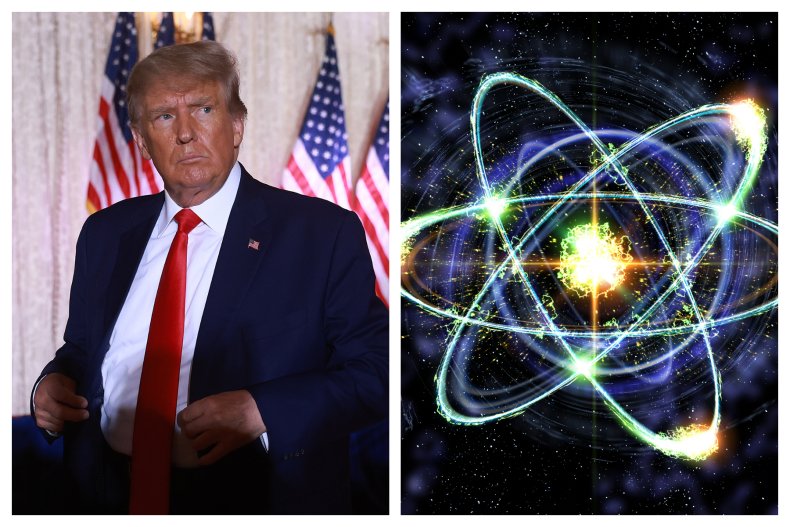Trump Team Explores Faster Nuclear Power Plant Development

Table of Contents
Streamlining the Nuclear Power Plant Approval Process
A major component of the Trump administration's plan focused on drastically reducing the bureaucratic hurdles associated with building new nuclear power plants. The process of obtaining permits and licenses from the Nuclear Regulatory Commission (NRC) is notoriously lengthy and complex, often leading to significant delays and cost overruns. The administration sought to streamline this process through regulatory reform, aiming for faster approvals and reduced construction times.
- Proposed Regulatory Changes: The administration explored various avenues for regulatory reform, including simplifying environmental impact statements and expediting the licensing review process. Specific proposals included reducing the number of required studies and streamlining the public comment period.
- Potential Benefits: Successful streamlining could have resulted in significantly faster construction times, leading to quicker deployment of new power plants and reduced overall costs. This could have made nuclear power more competitive with other energy sources.
- Potential Drawbacks: Critics argued that accelerating the approval process could compromise safety standards and environmental protections. Concerns were raised about inadequate public input and the potential for overlooking critical environmental impacts. The potential for overlooking crucial safety measures was also a point of significant contention.
Investing in Advanced Nuclear Reactor Technologies
The Trump administration also emphasized investment in advanced nuclear reactor technologies, such as Small Modular Reactors (SMRs) and other Generation IV reactors. These designs offer potential advantages over traditional large-scale reactors, including improved safety features, reduced construction costs, and greater flexibility in deployment.
- Advantages of SMRs and Advanced Reactors: SMRs are designed to be factory-built in modules, making them cheaper and faster to deploy than traditional reactors. They also offer enhanced safety features, such as passive safety systems that don't rely on active power.
- Government Funding and Support: The administration sought to increase government funding for research and development in advanced reactor technologies, hoping to stimulate innovation and private investment. This included tax credits and direct grants to companies developing these technologies.
- Challenges in Deploying New Technologies: Despite the potential benefits, deploying new reactor technologies faces significant hurdles. These include the need for extensive testing and certification, establishing a robust supply chain, and addressing public perception concerns associated with new technologies.
Economic Incentives and Public-Private Partnerships
To attract private investment in nuclear power plant construction, the Trump administration explored various economic incentives and encouraged public-private partnerships. The goal was to shift some of the financial burden from taxpayers to the private sector while encouraging innovation and competition.
- Types of Financial Incentives: Potential incentives included tax credits, subsidies, loan guarantees, and other forms of government support. The specific incentives were designed to offset the high initial investment costs associated with nuclear power plant construction.
- Examples of Successful Public-Private Partnerships: The administration highlighted successful partnerships in other sectors as models for collaboration in nuclear energy. The idea was to leverage private sector expertise and investment alongside government support.
- Potential Risks and Challenges: Public-private partnerships can be complex and challenging to manage. Issues such as risk allocation, profit sharing, and regulatory oversight need careful consideration to ensure a successful outcome.
Addressing Public Concerns and Safety
Perhaps the most significant challenge facing the accelerated development of nuclear power plants is public perception. Concerns regarding nuclear safety, waste disposal, and the potential for accidents have historically hampered the expansion of nuclear power. The Trump administration attempted to address these concerns through various measures.
- Measures to Improve Nuclear Safety and Waste Management: The administration emphasized the importance of rigorous safety standards and advanced waste management technologies. This included investing in research and development for advanced reactor designs with enhanced safety features and developing better solutions for long-term nuclear waste storage.
- Strategies to Enhance Public Communication and Transparency: Improving public communication and transparency was crucial to addressing public concerns. The administration aimed to provide clearer information on nuclear safety and waste management and to engage in open dialogue with the public.
- Ongoing Debates Surrounding Nuclear Waste Disposal: The long-term storage and disposal of nuclear waste remain a contentious issue. Finding safe and permanent solutions for nuclear waste remains a critical challenge for the nuclear industry.
Conclusion: The Future of Nuclear Power Plant Development
The Trump administration's push for accelerated nuclear power plant development presented a complex and multifaceted challenge. While the initiative offered the promise of enhanced energy independence, economic growth, and a reduction in reliance on fossil fuels, it also faced considerable headwinds. Concerns about safety, cost, and public perception proved to be significant obstacles. The long-term success of such initiatives hinges on successfully addressing these concerns through robust safety measures, transparent communication, and the development of innovative and cost-effective reactor technologies. Learn more about the ongoing debate surrounding faster nuclear power plant development and its impact on the nation's energy future.

Featured Posts
-
 Scenes De Menages Gerard Hernandez Parle De Son Partenariat Avec Chantal Ladesou
May 11, 2025
Scenes De Menages Gerard Hernandez Parle De Son Partenariat Avec Chantal Ladesou
May 11, 2025 -
 Della Maddalena Vs Muhammad Ufc 315 Main Card Results And Highlights
May 11, 2025
Della Maddalena Vs Muhammad Ufc 315 Main Card Results And Highlights
May 11, 2025 -
 Payton Pritchards Career Feat A Product Of His Upbringing
May 11, 2025
Payton Pritchards Career Feat A Product Of His Upbringing
May 11, 2025 -
 Alex Palous Pole Position Andrettis Indy Car Woes
May 11, 2025
Alex Palous Pole Position Andrettis Indy Car Woes
May 11, 2025 -
 The Thomas Mueller Situation Speculation Potential Destinations And Bayerns Response
May 11, 2025
The Thomas Mueller Situation Speculation Potential Destinations And Bayerns Response
May 11, 2025
